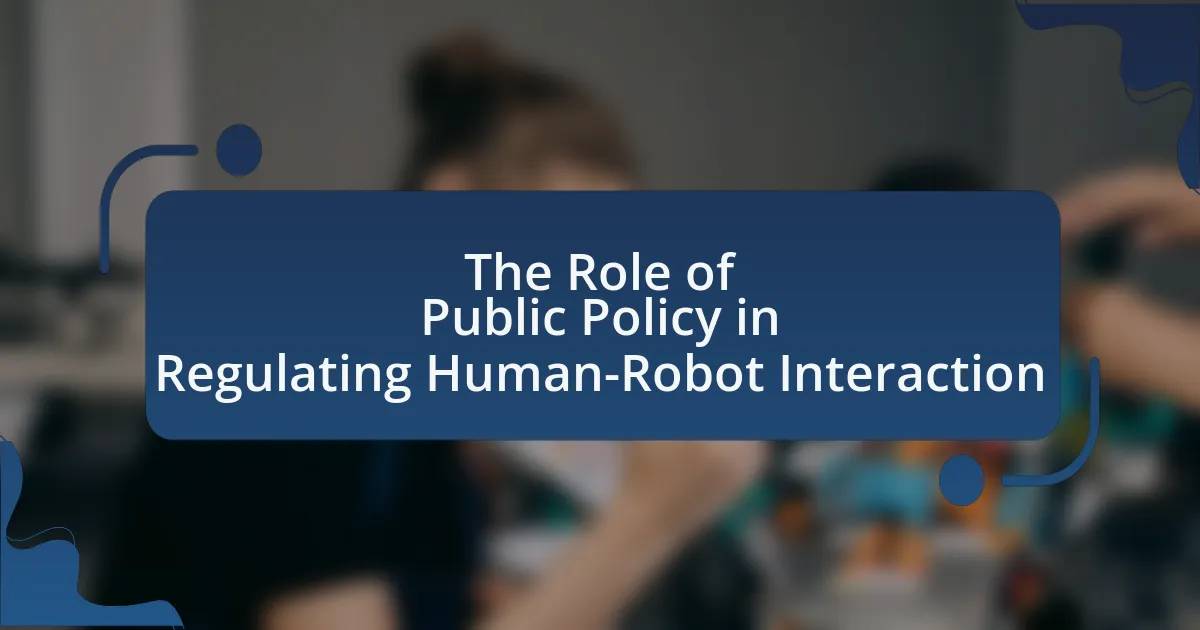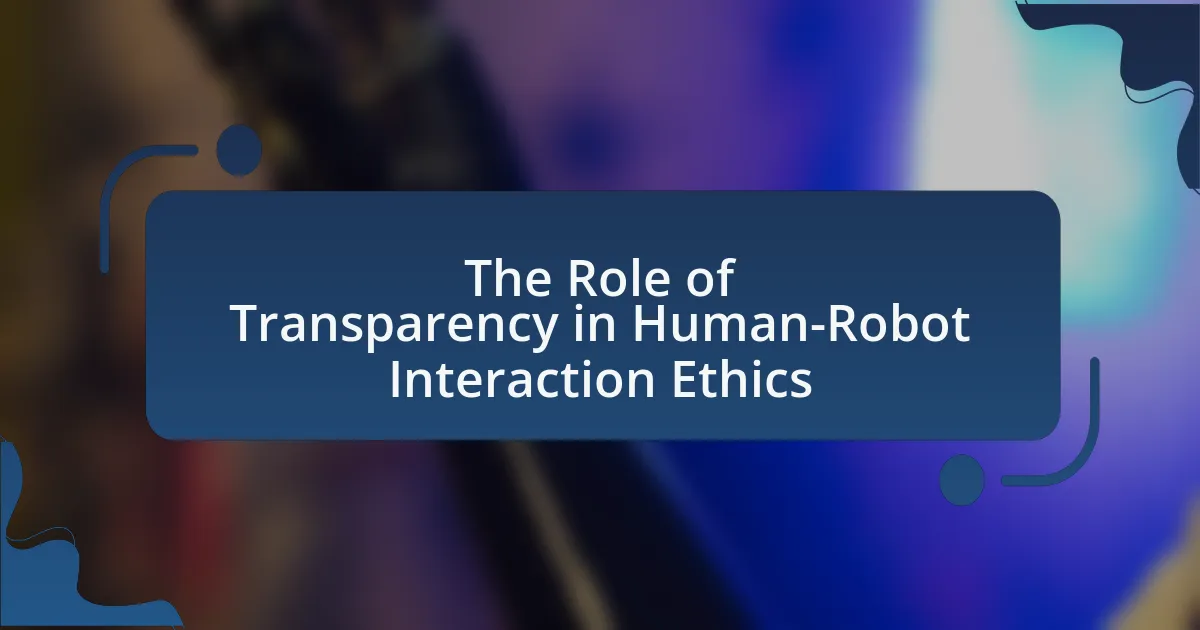The article examines the ethical dilemmas associated with the use of robots in disaster relief and rescue operations, focusing on issues of accountability, decision-making, and the potential for dehumanization of victims. It discusses how ethical considerations impact the deployment of robotic technologies, highlighting concerns such as privacy, the potential for harm, and the role of human operators in ensuring ethical practices. The article also explores how these ethical dilemmas vary across different types of disasters and emphasizes the importance of developing clear ethical guidelines and frameworks to govern robotic interventions in humanitarian efforts. Key takeaways include the necessity for transparency, human oversight, and prioritizing human safety in robotic operations.

What are the Ethical Dilemmas in the Use of Robots for Disaster Relief and Rescue Operations?
The ethical dilemmas in the use of robots for disaster relief and rescue operations primarily revolve around accountability, decision-making, and the potential for dehumanization. Accountability issues arise when robots make autonomous decisions that could lead to harm, raising questions about who is responsible for those actions. Decision-making dilemmas occur when robots must choose between conflicting priorities, such as saving lives versus preserving resources, which can lead to moral conflicts. Additionally, the use of robots may contribute to the dehumanization of victims, as reliance on technology can diminish the perceived value of human life and the emotional aspects of rescue efforts. These dilemmas highlight the need for careful consideration of ethical frameworks in the deployment of robotic technologies in critical situations.
How do ethical considerations impact the deployment of robots in disaster scenarios?
Ethical considerations significantly impact the deployment of robots in disaster scenarios by influencing decision-making processes regarding their use, capabilities, and limitations. These considerations include the potential for harm to human life, the need for accountability in robotic actions, and the importance of ensuring equitable access to technology. For instance, ethical frameworks often prioritize minimizing risks to human rescuers and victims, which can dictate the design and operational protocols of robots. Additionally, ethical guidelines may require transparency in how robots are programmed to make decisions, particularly in life-and-death situations, ensuring that their actions align with humanitarian principles. The integration of ethical considerations is essential for fostering public trust and acceptance of robotic technologies in critical disaster response efforts.
What are the primary ethical concerns associated with robotic intervention?
The primary ethical concerns associated with robotic intervention include accountability, privacy, and the potential for harm. Accountability arises because it can be unclear who is responsible for the actions of a robot, especially in critical situations where decisions can lead to life or death outcomes. Privacy concerns stem from the ability of robots to collect and process personal data without consent, raising issues about surveillance and data security. The potential for harm is significant, as robotic systems may malfunction or be misused, leading to unintended consequences that could endanger lives or exacerbate existing crises. These concerns highlight the need for clear ethical guidelines and regulations governing the deployment of robots in disaster relief and rescue operations.
How do these concerns vary across different types of disasters?
Concerns regarding the use of robots in disaster relief and rescue operations vary significantly across different types of disasters. In natural disasters like earthquakes and floods, ethical dilemmas often center on the reliability of robots in unstable environments and their ability to navigate complex terrains, which can impact rescue effectiveness. For instance, during the 2011 Japan earthquake, robotic systems faced challenges in debris removal and victim identification due to unpredictable conditions. In contrast, in man-made disasters such as terrorist attacks, concerns shift towards privacy and surveillance, as robots may collect sensitive data while performing their tasks. The 2013 Boston Marathon bombing response highlighted these issues, where the use of drones raised questions about civil liberties and the potential for misuse of surveillance technology. Thus, the type of disaster influences the ethical considerations surrounding robot deployment, emphasizing the need for tailored approaches to address specific challenges.
What role do human operators play in the ethical use of robots?
Human operators are crucial in ensuring the ethical use of robots, particularly in disaster relief and rescue operations. They are responsible for making decisions that align with ethical standards, such as prioritizing human safety and minimizing harm. For instance, operators must assess the context in which robots are deployed, ensuring that their actions do not infringe on human rights or exacerbate existing vulnerabilities. Furthermore, studies indicate that human oversight is essential for addressing moral dilemmas that arise during operations, as robots lack the capacity for ethical reasoning. This oversight helps to maintain accountability and transparency in the deployment of robotic systems, reinforcing the importance of human judgment in complex situations.
How does human oversight influence decision-making in robotic operations?
Human oversight significantly influences decision-making in robotic operations by ensuring ethical considerations and accountability are integrated into automated processes. This oversight allows humans to intervene in critical situations, guiding robots to make decisions that align with moral standards and societal values. For instance, in disaster relief scenarios, human operators can assess the context and adjust robotic actions to prioritize human safety and welfare, which is crucial when robots face complex ethical dilemmas, such as choosing between multiple rescue options. Studies have shown that human involvement can enhance the effectiveness of robotic systems, as operators can provide real-time judgment that machines may lack, thereby improving outcomes in high-stakes environments.
What are the implications of removing human operators from the equation?
Removing human operators from disaster relief and rescue operations can lead to increased efficiency and reduced risk to human life, but it also raises significant ethical concerns. The efficiency is evidenced by studies showing that robots can operate in hazardous environments where human presence is dangerous, thus potentially saving lives and resources. However, the lack of human oversight may result in ethical dilemmas, such as the inability to make nuanced decisions in complex situations, which robots may not be equipped to handle. Furthermore, the reliance on automated systems can lead to accountability issues, as it becomes unclear who is responsible for the actions taken by robots in critical scenarios.
What are the potential consequences of ethical dilemmas in robotic disaster response?
The potential consequences of ethical dilemmas in robotic disaster response include compromised decision-making, loss of public trust, and unintended harm to victims. When robots are programmed to make autonomous decisions in life-and-death situations, ethical dilemmas can arise, leading to choices that may prioritize efficiency over human safety. For instance, if a robot decides to prioritize saving a larger group of people at the expense of an individual, it may result in moral outrage and a perception of inhumanity. This can erode public trust in robotic systems, which is crucial for their acceptance and effectiveness in disaster scenarios. Furthermore, ethical misjudgments can lead to actions that inadvertently cause harm, such as misidentifying victims or failing to provide necessary aid, ultimately undermining the intended purpose of disaster response efforts.
How can ethical missteps affect the outcomes of rescue operations?
Ethical missteps can significantly compromise the effectiveness and safety of rescue operations. When rescue teams prioritize expediency over ethical considerations, they may overlook critical factors such as informed consent, the dignity of victims, and the potential for harm. For instance, deploying robots without proper assessment of their impact on human victims can lead to unintended injuries or psychological distress, as evidenced by studies showing that victims may feel dehumanized when treated as mere data points rather than individuals. Furthermore, ethical lapses can erode public trust in rescue operations, leading to reduced cooperation from affected communities, which is essential for successful outcomes. Historical examples, such as the misuse of technology in past disaster responses, illustrate that ethical considerations are paramount for ensuring both the efficacy and humanity of rescue efforts.
What are the long-term implications for public trust in robotic technologies?
The long-term implications for public trust in robotic technologies include increased skepticism and demand for transparency. As robotic technologies become more integrated into disaster relief and rescue operations, public perception will hinge on the reliability and ethical use of these systems. Studies indicate that transparency in decision-making processes and the demonstration of successful outcomes can enhance trust; for instance, a survey by the Pew Research Center found that 72% of respondents expressed concern about the ethical implications of robots in critical situations. Therefore, ongoing dialogue about ethical standards and accountability will be essential to foster and maintain public trust in robotic technologies.

How do Ethical Dilemmas Relate to Technological Advancements in Robotics?
Ethical dilemmas are intrinsically linked to technological advancements in robotics, particularly in disaster relief and rescue operations, as these advancements often challenge existing moral frameworks. The deployment of robots in life-and-death situations raises questions about accountability, decision-making, and the potential for harm, which are central to ethical considerations. For instance, the use of autonomous drones for search and rescue can lead to dilemmas regarding the prioritization of human lives versus the efficiency of robotic operations. Research by Lin et al. (2017) in “Robot Ethics: The Ethical and Social Implications of Robotics” highlights that as robots become more autonomous, the ethical implications of their actions become increasingly complex, necessitating a reevaluation of ethical standards in technology. Thus, the relationship between ethical dilemmas and technological advancements in robotics is characterized by the need to address the moral implications of deploying increasingly capable machines in sensitive and critical environments.
What advancements in robotics are raising new ethical questions?
Advancements in robotics, such as autonomous decision-making capabilities and the integration of artificial intelligence, are raising new ethical questions regarding accountability and the moral implications of machine actions. For instance, the deployment of drones and robotic systems in disaster relief can lead to situations where these machines must make life-and-death decisions without human intervention, challenging traditional notions of responsibility. Additionally, the use of surveillance robots in rescue operations raises concerns about privacy and consent, as these technologies can collect sensitive data without the knowledge of affected individuals. These ethical dilemmas highlight the need for clear guidelines and frameworks to govern the use of robotics in critical situations.
How do autonomous decision-making capabilities challenge existing ethical frameworks?
Autonomous decision-making capabilities challenge existing ethical frameworks by introducing complexities in accountability and moral responsibility. Traditional ethical frameworks, such as deontology and utilitarianism, rely on human judgment to assess actions and outcomes. However, when robots make decisions independently, it becomes unclear who is responsible for their actions, especially in high-stakes scenarios like disaster relief. For instance, if an autonomous robot prioritizes saving one individual over another based on programmed algorithms, it raises questions about the ethical implications of such choices and the potential for bias in decision-making processes. This shift necessitates a reevaluation of ethical principles to address the implications of machine autonomy, as highlighted in studies like “Ethics of Autonomous Systems” by the IEEE Global Initiative on Ethics of Autonomous and Intelligent Systems, which emphasizes the need for new ethical guidelines that account for the capabilities and limitations of autonomous technologies.
What are the risks associated with increased automation in disaster response?
Increased automation in disaster response poses several risks, including reduced human oversight, potential technical failures, and ethical concerns regarding decision-making. The reliance on automated systems can lead to situations where critical decisions are made without human intervention, increasing the likelihood of errors in rapidly changing environments. For instance, a study by the National Institute of Standards and Technology highlights that automated systems may misinterpret data, leading to inappropriate responses during emergencies. Additionally, ethical dilemmas arise when robots are tasked with making life-and-death decisions, raising questions about accountability and moral responsibility. These factors underscore the complexities and potential dangers associated with integrating automation into disaster response efforts.
How can ethical guidelines be developed for robotic use in disaster scenarios?
Ethical guidelines for robotic use in disaster scenarios can be developed through a collaborative framework involving stakeholders such as ethicists, engineers, disaster response professionals, and affected communities. This approach ensures that diverse perspectives are considered, addressing potential ethical dilemmas like autonomy, accountability, and the impact on human lives. For instance, the IEEE Global Initiative on Ethics of Autonomous and Intelligent Systems provides a structured methodology for integrating ethical considerations into technology design, emphasizing transparency and human oversight. By utilizing established ethical frameworks and engaging in continuous dialogue, guidelines can be refined to adapt to evolving challenges in disaster response.
What frameworks currently exist for ethical robotics in humanitarian efforts?
Several frameworks currently exist for ethical robotics in humanitarian efforts, including the IEEE Global Initiative on Ethics of Autonomous and Intelligent Systems, the Asilomar AI Principles, and the UN’s Guidelines for the Ethical Use of AI in Humanitarian Action. The IEEE framework emphasizes the importance of transparency, accountability, and the well-being of affected populations, while the Asilomar principles focus on ensuring that AI technologies are developed and used in a manner that is beneficial to humanity. The UN guidelines provide a comprehensive approach to integrating ethical considerations into the deployment of AI and robotics in humanitarian contexts, promoting respect for human rights and dignity. These frameworks collectively aim to guide the responsible use of robotics in disaster relief and rescue operations, ensuring that ethical considerations are prioritized in the development and application of these technologies.
How can stakeholders collaborate to create effective ethical guidelines?
Stakeholders can collaborate to create effective ethical guidelines by establishing a multi-disciplinary task force that includes representatives from technology developers, ethicists, disaster response organizations, and affected communities. This collaborative approach ensures diverse perspectives are considered, leading to comprehensive guidelines that address various ethical concerns. For instance, the IEEE Global Initiative on Ethics of Autonomous and Intelligent Systems emphasizes the importance of stakeholder engagement in developing ethical standards, highlighting that inclusive dialogue can identify potential risks and ethical dilemmas associated with robotic use in disaster scenarios. By leveraging expertise from different fields, stakeholders can create guidelines that are not only practical but also socially responsible, ensuring that the deployment of robots in disaster relief aligns with societal values and ethical principles.

What are the Best Practices for Addressing Ethical Dilemmas in Robotic Disaster Relief?
Best practices for addressing ethical dilemmas in robotic disaster relief include establishing clear ethical guidelines, ensuring transparency in decision-making, and prioritizing human oversight. Clear ethical guidelines help define acceptable actions for robots in complex situations, such as prioritizing human life and minimizing harm. Transparency in decision-making allows stakeholders to understand the rationale behind robotic actions, fostering trust among affected communities. Prioritizing human oversight ensures that critical decisions remain under human control, preventing potential misuse of robotic capabilities. These practices are supported by frameworks like the IEEE Global Initiative on Ethics of Autonomous and Intelligent Systems, which emphasizes the importance of ethical considerations in technology deployment.
What strategies can be implemented to mitigate ethical concerns?
To mitigate ethical concerns in the use of robots for disaster relief and rescue operations, organizations can implement strategies such as establishing clear ethical guidelines, ensuring transparency in decision-making, and involving stakeholders in the development process. Clear ethical guidelines provide a framework for acceptable behavior and decision-making, which can help prevent misuse of technology. Transparency in decision-making fosters trust among stakeholders, as it allows for scrutiny and accountability. Involving stakeholders, including affected communities and ethicists, ensures that diverse perspectives are considered, leading to more ethically sound practices. These strategies are supported by research indicating that ethical frameworks and stakeholder engagement significantly reduce ethical dilemmas in technology deployment.
How can training programs for operators enhance ethical decision-making?
Training programs for operators can enhance ethical decision-making by providing structured frameworks and scenarios that promote critical thinking about ethical dilemmas. These programs often include case studies, role-playing exercises, and discussions that help operators understand the implications of their decisions in disaster relief contexts. Research indicates that training focused on ethical reasoning improves decision-making quality; for instance, a study published in the Journal of Business Ethics found that ethics training significantly increased participants’ ability to identify ethical issues and consider the consequences of their actions. By equipping operators with the tools to navigate complex moral landscapes, training programs foster a culture of ethical awareness and responsibility in high-stakes environments.
What role does public engagement play in shaping ethical practices?
Public engagement plays a crucial role in shaping ethical practices by fostering dialogue between stakeholders, including the public, policymakers, and technologists. This interaction helps to identify societal values and concerns regarding the use of robots in disaster relief and rescue operations. For instance, public forums and surveys can reveal community expectations about privacy, safety, and accountability, which are essential for developing ethical guidelines. Research indicates that inclusive decision-making processes lead to more socially acceptable and ethically sound practices, as seen in the development of ethical frameworks for emerging technologies.
What lessons can be learned from past robotic disaster relief operations?
Past robotic disaster relief operations highlight the importance of adaptability, effective communication, and ethical considerations in deployment. For instance, the use of drones in the aftermath of the 2015 Nepal earthquake demonstrated that real-time data collection and aerial surveillance significantly improved situational awareness, allowing for more efficient resource allocation. Additionally, the 2011 Fukushima disaster revealed that robots must be designed to operate in unpredictable environments, emphasizing the need for robust engineering and contingency planning. Ethical dilemmas also emerged, such as the balance between human oversight and robotic autonomy, which necessitates clear guidelines to ensure accountability and safety. These lessons underscore the necessity for continuous improvement in technology and ethical frameworks to enhance the effectiveness of robotic interventions in future disaster scenarios.
What case studies highlight ethical dilemmas faced in real-world scenarios?
Case studies that highlight ethical dilemmas in the use of robots for disaster relief and rescue operations include the 2011 Fukushima nuclear disaster and the 2010 Haiti earthquake. In Fukushima, the deployment of robots raised concerns about the safety of human operators versus the effectiveness of robotic intervention in hazardous environments. Ethical questions emerged regarding the decision to prioritize human lives over technological capabilities, as robots were unable to perform certain tasks effectively due to environmental challenges. In Haiti, the use of drones for delivering supplies sparked debates about privacy and surveillance, as well as the potential for exacerbating existing inequalities in disaster response. These case studies illustrate the complex ethical considerations that arise when integrating robotic technology into critical humanitarian efforts.
How can these lessons inform future robotic deployments in disaster relief?
Lessons learned from previous robotic deployments in disaster relief can inform future efforts by emphasizing the importance of ethical considerations, operational efficiency, and adaptability. For instance, the deployment of drones in the aftermath of Hurricane Harvey highlighted the need for clear guidelines on privacy and data collection, ensuring that victims’ rights are respected while utilizing technology for rescue operations. Additionally, the use of ground robots in the 2011 Fukushima disaster demonstrated the necessity for robots to be designed for diverse environments, allowing them to navigate complex terrains effectively. These experiences underscore the importance of integrating ethical frameworks and robust design principles into future robotic systems to enhance their effectiveness and acceptance in disaster scenarios.
What are the key takeaways for ensuring ethical robotic operations in disaster relief?
Key takeaways for ensuring ethical robotic operations in disaster relief include prioritizing human safety, ensuring transparency in decision-making, and maintaining accountability for robotic actions. Human safety must be the foremost consideration, as robots should not endanger lives during operations; for instance, the deployment of drones in search and rescue must be carefully managed to avoid collisions with rescuers or victims. Transparency is essential, as stakeholders need to understand how robots make decisions, which can be achieved through clear communication of algorithms and operational protocols. Accountability is crucial, as there must be mechanisms in place to address any harm caused by robotic actions, ensuring that operators and developers are responsible for the outcomes of their technologies. These principles are supported by ethical frameworks in robotics, such as the IEEE Global Initiative on Ethics of Autonomous and Intelligent Systems, which emphasizes the importance of ethical considerations in technology deployment.





